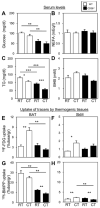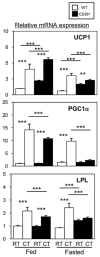CD36 is indispensable for thermogenesis under conditions of fasting and cold stress
- PMID: 25596128
- PMCID: PMC4344115
- DOI: 10.1016/j.bbrc.2014.12.124
CD36 is indispensable for thermogenesis under conditions of fasting and cold stress
Abstract
Hypothermia can occur during fasting when thermoregulatory mechanisms, involving fatty acid (FA) utilization, are disturbed. CD36/FA translocase is a membrane protein which facilitates membrane transport of long-chain FA in the FA consuming heart, skeletal muscle (SkM) and adipose tissues. It also accelerates uptake of triglyceride-rich lipoprotein by brown adipose tissue (BAT) in a cold environment. In mice deficient for CD36 (CD36(-/-) mice), FA uptake is markedly reduced with a compensatory increase in glucose uptake in the heart and SkM, resulting in lower levels of blood glucose especially during fasting. However, the role of CD36 in thermogenic activity during fasting remains to be determined. In fasted CD36(-/-) mice, body temperature drastically decreased shortly after cold exposure. The hypothermia was accompanied by a marked reduction in blood glucose and in stores of triacylglycerols in BAT and of glycogen in glycolytic SkM. Biodistribution analysis using the FA analogue (125)I-BMIPP and the glucose analogue (18)F-FDG revealed that uptake of FA and glucose was severely impaired in BAT and glycolytic SkM in cold-exposed CD36(-/-) mice. Further, induction of the genes of thermogenesis in BAT was blunted in fasted CD36(-/-) mice after cold exposure. These findings strongly suggest that CD36(-/-) mice exhibit pronounced hypothermia after fasting due to depletion of energy storage in BAT and glycolytic SkM and to reduced supply of energy substrates to these tissues. Our study underscores the importance of CD36 for nutrient homeostasis to survive potentially life-threatening challenges, such as cold and starvation.
Keywords: Brown adipose tissue; CD36; Fatty acid; Hypothermia; Skeletal muscle.
Copyright © 2015 Elsevier Inc. All rights reserved.
Conflict of interest statement
Figures




Similar articles
-
Fatty acid binding protein 4 and 5 play a crucial role in thermogenesis under the conditions of fasting and cold stress.PLoS One. 2014 Mar 6;9(6):e90825. doi: 10.1371/journal.pone.0090825. eCollection 2014. PLoS One. 2014. PMID: 24603714 Free PMC article.
-
Loss of UCP2 impairs cold-induced non-shivering thermogenesis by promoting a shift toward glucose utilization in brown adipose tissue.Biochimie. 2017 Mar;134:118-126. doi: 10.1016/j.biochi.2017.01.006. Epub 2017 Jan 24. Biochimie. 2017. PMID: 28130074
-
Glucose uptake in human brown adipose tissue is impaired upon fasting-induced insulin resistance.Diabetologia. 2015 Mar;58(3):586-95. doi: 10.1007/s00125-014-3465-8. Epub 2014 Dec 13. Diabetologia. 2015. PMID: 25500952 Clinical Trial.
-
Origins and early development of the concept that brown adipose tissue thermogenesis is linked to energy balance and obesity.Biochimie. 2017 Mar;134:62-70. doi: 10.1016/j.biochi.2016.09.007. Epub 2016 Sep 10. Biochimie. 2017. PMID: 27621146 Review.
-
Role of CD36 in membrane transport and utilization of long-chain fatty acids by different tissues.J Mol Neurosci. 2001 Apr-Jun;16(2-3):117-21; discussion 151-7. doi: 10.1385/JMN:16:2-3:117. J Mol Neurosci. 2001. PMID: 11478366 Review.
Cited by
-
Common and differential transcriptional responses to different models of traumatic stress exposure in rats.Transl Psychiatry. 2018 Aug 23;8(1):165. doi: 10.1038/s41398-018-0223-6. Transl Psychiatry. 2018. PMID: 30139969 Free PMC article.
-
Endothelial NOX5 Expression Modulates Thermogenesis and Lipolysis in Mice Fed with a High-Fat Diet and 3T3-L1 Adipocytes through an Interleukin-6 Dependent Mechanism.Antioxidants (Basel). 2021 Dec 24;11(1):30. doi: 10.3390/antiox11010030. Antioxidants (Basel). 2021. PMID: 35052534 Free PMC article.
-
A-FABP mediates adaptive thermogenesis by promoting intracellular activation of thyroid hormones in brown adipocytes.Nat Commun. 2017 Jan 27;8:14147. doi: 10.1038/ncomms14147. Nat Commun. 2017. PMID: 28128199 Free PMC article.
-
Age-related alteration of the involvement of CD36 for salivary secretion from the parotid gland in mice.J Physiol Sci. 2024 Jul 29;74(1):38. doi: 10.1186/s12576-024-00931-6. J Physiol Sci. 2024. PMID: 39075341 Free PMC article.
-
Characterization of BAT activity in rats using invasive and non-invasive techniques.PLoS One. 2019 May 15;14(5):e0215852. doi: 10.1371/journal.pone.0215852. eCollection 2019. PLoS One. 2019. PMID: 31091250 Free PMC article.
References
-
- Cannon B, Nedergaard J. Brown adipose tissue: function and physiological significance. Physiol Rev. 2004;84:277–359. - PubMed
-
- Klingenspor M. Cold-induced recruitment of brown adipose tissue thermo-genesis. Exp Physiol. 2003;88:141–148. - PubMed
-
- Syamsunarno MR, Iso T, Yamaguchi A, Hanaoka H, Putri M, Obokata M, Sunaga H, Koitabashi N, Matsui H, Maeda K, Endo K, Tsushima Y, Yokoyama T, Kurabayashi M. Fatty acid binding protein 4 and 5 play a crucial role in thermogenesis under the conditions of fasting and cold stress. PLoS One. 2014;9:e90825. - PMC - PubMed
-
- Haman F. Shivering in the cold: from mechanisms of fuel selection to survival. J Appl Physiol. 2006;100:1702–1708. - PubMed
Publication types
MeSH terms
Substances
Grants and funding
LinkOut - more resources
Full Text Sources
Other Literature Sources
Molecular Biology Databases

